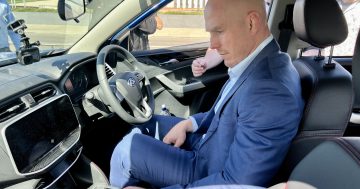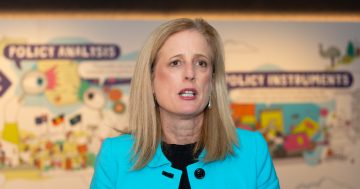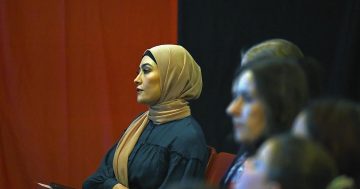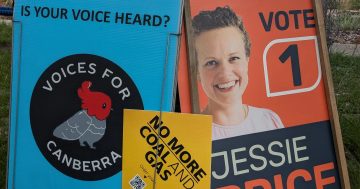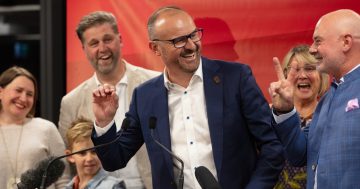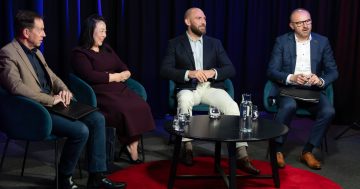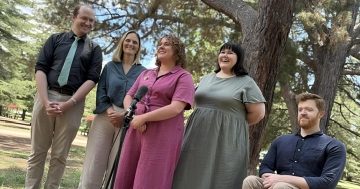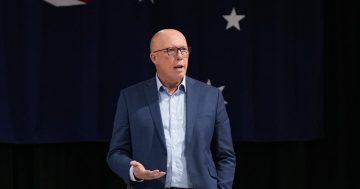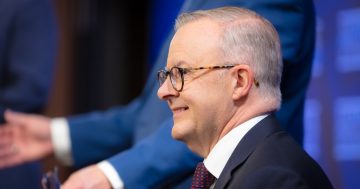
Former chief minister and ACT Senator Katy Gallagher is likely to be re-elected comfortably on 21 May. Photo: File.
Prime Minister Scott Morrison has announced the next federal election will be held on 21 May.
News crews tracked the PM’s every move this morning (10 April) from Kirribilli House to landing at Fairbairn, his journey along Adelaide Avenue to see the Governor General and then back to Parliament House, before Mr Morrison made the long anticipated announcement in the Parliament House courtyard around 11:20 am.
“I love this country and I love Australians, I know Australians have been through a few tough times, I know Australia continues to face very tough challenges in the years ahead,” Mr Morrison said.
Pointing to the likely campaign theme for the Liberals, Mr Morrison noted low unemployment and a strong economic recovery from the pandemic including retaining the nation’s triple A credit rating. He portrayed the Labor Opposition as fiscally irresponsible and unable to manage money.
“Our government is not perfect and we’ve never claimed to be,” Mr Morrison said. “You may see some flaws but you can see what we have achieved.”
National polls show deep-seated dissatisfaction with the Morrison Government and a particular dislike of the PM himself, who has weathered a storm of internal criticism over the past weeks. Much of the criticism comes from retiring Liberal politicians who have characterised Mr Morrison as a ruthless bully and a liar.
The campaign is deliberately long, intended to draw out Labor’s weaknesses and capitalise on the PM’s marketing background. Polls have shown for some time that only two per cent of voters are undecided about the Prime Minister while Opposition leader Anthony Albanese has a wider margin to manage.
The Opposition leader is, nevertheless, a long term politician and former Federal minister who is responding to criticism by noting his personal economic credentials and the current government’s high spending record.
The wild card nationally belongs to independents, many of whom have been funded by investors keen to see significant action on climate change.
In NSW, there’s been a lengthy debacle and court challenges over pre-selection, meaning that many candidates have only just been endorsed. The risk for NSW Liberals is that well established independent candidates have already gained significant momentum and key name recognition.
So what will happen in the Australian Capital Territory? There’s little chance of change in the House of Representatives where no significant opposition has materialised against Andrew Leigh in Fenner and Dave Smith in Bean.
Alicia Payne faces a challenge from Tim Hollo in the central seat of Canberra, following major gains for the Greens in the last ACT election. The party has been busy suggesting to voters in the Inner North that with a few thousand more votes, Hollo could take on the incumbent.
However Payne is well liked locally and sits on a huge margin of more than 17 per cent. It’s likely that Canberra remains a safe Labor seat as Hollo would be relying on centrist Liberal preferences to win, a local phenomenon that may not be repeated in a Federal election where the Labor incumbency factor is absent.
The real competition will be in the Senate where a record number of plausible independent candidates are standing, all hoping to unseat the generally unpopular Zed Seselja. Can they validate the persistent Canberra belief that centre left progressive candidates will defeat a hard right incumbent?
David Pocock has gained some traction on name recognition, enough to unsettle Senator Seselja who has been pointing to the former Wallaby’s allegedly “extreme green” Extinction Rebellion history.
Professor Kim Rubenstein has gathered strong community support while the Greens are running Tjanara Goreng Goreng, also a familiar face on the campaign trail.
Recent polling was commissioned by the Climate 200 campaign, which is providing seed funding to multiple independent candidates nationally. It showed Senator Seselja well short of a quota with 24 and 25 per cent of the primary vote in both polls.
This is nothing new, however: in 2019, Senator Seselja brushed off the Greens’ challenge despite the Liberal vote again dipping below quota, to 32.4 per cent, but there were plenty of preferences to get him home comfortably.
This time around, it’s probable that most Green and independent preferences will flow to Katy Gallagher, whose ACT Senate seat is as safe as they come. The independents need to overcome Senator Seselja’s rusted-on support before taking swinging votes from the Liberals.
In neighbouring NSW, Kristy McBain sits on a slender margin in Eden-Monaro but in an election where the momentum will be with the ALP, late-comer Jerry Nockles is unlikely to trouble her. The national bellwether is increasingly a reliable Labor seat and won’t easily change hands this time around.












